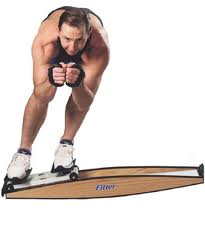Archive for the ‘Skating’ Category
Sunday, June 10th, 2012
It was a beautiful spring day for a roll on the trail.

My ski season doesn’t end until after Memorial Day, but with the arrival of spring, the early Daylight Saving time and our first hot spell, I chose a day in late April for my first skating workout of the year. I literally dusted off my skates (we’ve just survived a complete kitchen remodel), and hit the streets, relishing the faint vibrations of urethane on smooth pavement. Read more... (529 words, 2 images, estimated 2:07 mins reading time)
Tags:Trail skating safety hazards
Posted in Liz's Journal, Skating | Comments Closed
Sunday, June 10th, 2012
(Updated GetRolling.com article from 1996)
Because all the world is not a stage (flat, smooth, protected), I make time in every lesson to help my students work on real-world skills and drills designed to improve overall balance and agility. Aside from the safety aspect, it’s always fun to have a frisky move or two to impress your friends. As always, gear up before experimenting.
Get Air
 How are your hopping skills? Being able to get both skates off the ground at the same time is a prerequisite to hopping up a curb. Out in the real world, this is an essential safety skill: it’s often necessary to hop over an electrical line seen at the last minute. Try your first hops on the lawn or carpet and remember these key points: Read more... (679 words, 3 images, estimated 2:43 mins reading time)
How are your hopping skills? Being able to get both skates off the ground at the same time is a prerequisite to hopping up a curb. Out in the real world, this is an essential safety skill: it’s often necessary to hop over an electrical line seen at the last minute. Try your first hops on the lawn or carpet and remember these key points: Read more... (679 words, 3 images, estimated 2:43 mins reading time)
Tags:agility, curbs, hopping, mobility, real-world, toe rolls, tricks, urban
Posted in Skating | Comments Closed
Sunday, June 10th, 2012
I can’t believe it’s been five years since I tested Alex Bellehumeur’s impressive cuff-activated disc braking technology, currently named the 4XS system. Why isn’t this system available on inline skates yet? Because manufacturers just don’t get it. They underestimate how much and how many people care about staying in control of gravity and momentum when they’re inline skating.
My efforts to support Alex’s attempts to get the 4XS into production have probably helped raise awareness a little, but have not yet resulted in improving the safety of our current technology: Read more... (384 words, estimated 1:32 mins reading time)
Tags:braking systems, heel brake, stopping, technology
Posted in Gear, Skating | Comments Closed
Sunday, June 10th, 2012

Your friendly crossing guard is here to point you to a few choice inline destinations shared from friends across the Internet. Read more... (141 words, 2 images, estimated 34 secs reading time)
- YouTube – A unique style of skating was all the rage in France in 1923. (Thanks to OttawaSpeedskating)
- YouTube – Off-skates training for Olympic ice skaters in 1953. (Thanks to Mike van Erp, LondonSkaters.com)
- Inline Planet – Get the latest inline skating news and views
- See how new instructors are cultivated across the globe by ICP International.
- Destination Florida! – Anybody who has just graduated from Camp Rollerblade with all of the basic skills (stopping, turning and skating at least 5 miles) will enjoy this 5-day skate tour.
Posted in Sk8 Links, Skating | Comments Closed
Saturday, October 15th, 2011
A couple months back, I received a note from Susie, who lives and skates in New Zealand. I love answering questions from all over the world but she definitely won my heart when she confided as an aside, “I milk cows and like to skate as a way to vent, and I just plain enjoy it.”
I was able to offer generic advice up front, but once Susie placed her (first) order, she took off rolling on her own exploration to finally get the right skates to meet her own needs and skeletal configuration. Read more... (1229 words, 3 images, estimated 4:55 mins reading time)
Tags:Gear
Posted in Gear, Skating | Comments Closed
Sunday, September 25th, 2011
It’s getting to be that time of year again.
A few years back, I purchased a ProFitter 3D Trainer because it would allow me to work on building strength and balance along with my cardiovascular fitness. This is an ideal sport-specific workout that’s perfect for when the weather is too ugly to train outdoors.
 For skating, the slide board-like action reinforces the side-directed push that’s key to stroke quality. This directly works the muscles that deliver efficient, powerful strides. Read more... (320 words, 1 image, estimated 1:17 mins reading time)
For skating, the slide board-like action reinforces the side-directed push that’s key to stroke quality. This directly works the muscles that deliver efficient, powerful strides. Read more... (320 words, 1 image, estimated 1:17 mins reading time)
Tags:cross training, off-season workouts, pro fitter, skate to ski, work out
Posted in Fitness, Gear, Skating | Comments Closed
Saturday, September 24th, 2011
Do you need breathing lessons? This question might sound ridiculous, but if you want to skate long distances efficiently, you must be able to get all the oxygen your hard-working body needs.
Here is how to find out how you currently breathe: sit up straight, place your hands on your stomach below the belt line and take a very deep breath. Did your hands move in toward your spine? If yes, you have just filled only the top portion of your lungs. Your diaphragm stayed tight, blocking the path to a full intake of air. Inline skaters (and all humans) need a rich intake of oxygen with every inhalation. Read more... (313 words, 1 image, estimated 1:15 mins reading time)
Tags:breath, meditation, mind-body, oxygen intake
Posted in Fitness, Skating | Comments Closed
Tuesday, September 13th, 2011
Eighteen years ago as I was writing the early chapters of my book, Get Rolling, the Beginner’s Guide to Inline Skating, I had already forgotten that it took about 20 hours of practice before I was finally able to skate without feeling like a klutz. Once my tentative, awkward, uncoordinated days were behind me, all I could think of as I wrote my book was:
Wow! Anybody who can walk can skate! I need to tell the world about this!
And that is when I became a certified instructor and began offering skating lessons to demystify the sport for adults. Read more... (613 words, 1 image, estimated 2:27 mins reading time)
Tags:alternatives, Opinion, rollerblading
Posted in Gear, Skating | 4 Comments »
Sunday, September 4th, 2011
On a recent gorgeous summer Sunday morning, I decided to see how the northern section of my local favorite skating trail was faring. I hadn’t been there for awhile because I prefer to get my skate workouts on the southern section of the Iron Horse Trail where there are less intersections. The central section’s trees behind the high school tend to drop a lot of leaves and twigs on the trail. (I still have a scar on my knee from that stretch.) Also, loitering teens tend to block the trail right behind the school. Read more... (482 words, 1 image, estimated 1:56 mins reading time)
Tags:California, family exercise, helmet use, multi use trails, rail trail
Posted in Skating | Comments Closed
Sunday, September 4th, 2011
During my weekend skating jaunts on the local multi-use trail in Danville, it tickles me to see families enjoying the outdoors together—getting a little exercise on foot, bikes, scooters, or skates; walking the dog; and just generally sharing quality recreational time. What a great way for parents to share the fun and benefits of playing outdoors as a family! I always hope the kids are building memories that will guide their values as adults, and that they, too, will make it a point to participate often in the great outdoors with friends and family. Read more... (357 words, 1 image, estimated 1:26 mins reading time)
Tags:family safety recreation
Posted in Gear, Skating | Comments Closed



